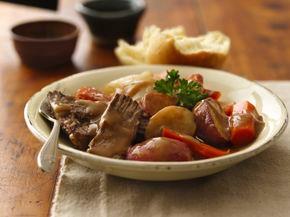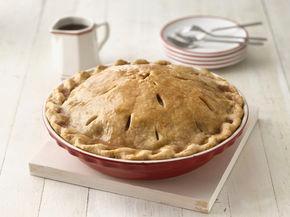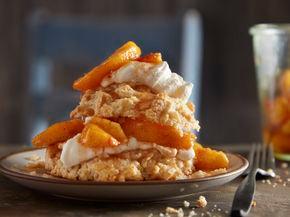
New England Pot Roast
- 30 Minutes Prep4 Hours Total
- 8 Servings
- 370 Calories per Serving
This pot roast goes from a dinner favorite to a dinner must-have thanks to the horseradish that gets spread on the outside of the roast. This classic recipe can easily be tailored to your family’s liking using a few ingredient swaps. Check out our Expert Tips section for instructions on how to make a cream gravy pot roast or garlic-herb roast—you won’t regret it!
Ingredient List
- 1 boneless beef chuck arm, shoulder or blade pot roast (4 lb)
- 1 to 2 teaspoons salt
- 1 teaspoon pepper
- 1 jar (8 oz) prepared horseradish
- 1 cup water
- 8 small potatoes, cut in half
- 8 medium carrots, cut into fourths
- 8 small onions, skins removed
- 1/2 cup cold water
- 1/4 cup Gold Medal™ all-purpose flour
Preparation
- In 4-quart Dutch oven, cook beef over medium heat until brown on all sides. Reduce heat to low.
- Sprinkle beef with salt and pepper. Spread horseradish over all sides of beef. Add 1 cup water to Dutch oven. Heat to boiling; reduce heat. Cover and simmer 2 hours 30 minutes.
- Add potatoes, carrots and onions to Dutch oven. Cover and simmer about 1 hour or until beef and vegetables are tender.
- Remove beef and vegetables to warm platter; keep warm. Skim excess fat from broth in Dutch oven. Add enough water to broth to measure 2 cups. In tightly covered container, shake 1/2 cup cold water and the flour; gradually stir into broth. Heat to boiling, stirring constantly. Boil and stir 1 minute. Serve gravy with beef and vegetables.
Tips
- You can find prepared horseradish in glass jars in the condiment section of your supermarket.
- Skip the gravy and serve with more horseradish or a fruit chutney.
- To carve the roast, place on carving board or serving platter so the meat grain runs parallel to carving board. Holding meat in place with meat fork, cut meat across grain into 1/4-inch slices.
- For Cream Gravy Pot Roast, substitute 1 can (10.5 ounces) condensed beef broth for the 1 cup water. For the gravy in step 4, add enough half-and-half or milk, instead of water, to the broth (from the roast) to measure 2 cups. Substitute 1/2 cup half-and-half or milk for the 1/2 cup cold water.
- For Garlic-Herb Pot Roast, decrease pepper to 1/2 teaspoon and omit horseradish. After browning beef in step 1, sprinkle with 1 tablespoon chopped fresh or 1 teaspoon dried marjoram leaves, 1 tablespoon chopped fresh or 1 teaspoon dried thyme leaves, 2 teaspoons chopped fresh or 1/2 teaspoon dried oregano leaves and 4 cloves garlic, finely chopped. Substitute 1 can (10.5 ounces) condensed beef broth for the 1 cup water.
- Slow Cooker Directions: In 12-inch skillet, cook beef over medium heat until brown on all sides. In 4- to 6-quart slow cooker, place potatoes, carrots and onions. Place beef on vegetables. In small bowl, mix horseradish, salt and pepper; spread evenly over beef. Pour water into slow cooker. Cover and cook on Low heat setting 8 to 10 hours.
Nutrition Information
Servings: 8
Serving size: 1 Serving
Amount per serving (Calories ): 370
| Food component / Nutrient | Amount | % Daily Value* |
|---|---|---|
| Total Fat | 11g | 17% |
| Saturated Fat | 4g | 20% |
| Trans Fat | 0g | % Value not available |
| Cholesterol | 85mg | 28% |
| Sodium | 470mg | 20% |
| Total Carbohydrate | 32g | 11% |
| Dietary Fiber | 5g | 21% |
| Soluble Fiber | 2g | % Value not available |
| Sugars | 7g | % Value not available |
| Protein | 35g | % Value not available |
| Vitamin D | Value not available | 6% |
| Vitamin E | Value not available | 2% |
| Calcium | Value not available | 6% |
| Iron | Value not available | 30% |
| Potassium | 1260mg | 36% |
| Thiamin | Value not available | 15% |
| Riboflavin | Value not available | 20% |
| Niacin | Value not available | 40% |
| Vitamin B6 | Value not available | 45% |
| Vitamin B12 | Value not available | 35% |
| Pantothenic Acid | Value not available | 10% |
| Phosphorus | Value not available | 35% |
| Magnesium | Value not available | 20% |
| Zinc | Value not available | 45% |
| Manganese | Value not available | 25% |
| Selenium | Value not available | 40% |
| Copper | Value not available | 20% |
*The % Daily Value (DV) tells you how much a nutrient in a serving of food contributes to a daily diet. 2,000 calories a day is used for general nutrition advice. | ||
Exchanges
- Starch 1&½,
- Fruit 0,
- Other Carbohydrate 0,
- Skim Milk 0,
- Low-Fat Milk 0,
- Milk 0,
- Vegetable 2,
- Very Lean Meat 4,
- Lean Meat 0,
- Medium-Fat Meat 0,
- High-Fat Meat 0,
- Fat 1,
- Fruits NC†, NC indicates a nutritional value has not been calculated,
- Vegetables NC†,
- Grains NC†,
- Meat & Beans NC†,
- Dairy NC†,
- Fats & Oils NC†
† NC indicates a nutritional value has not been calculated, which is typically due to either insufficient nutritional data for an ingredient or an incomplete analysis.
Carbohydrate Choice
- Choices per serving2





